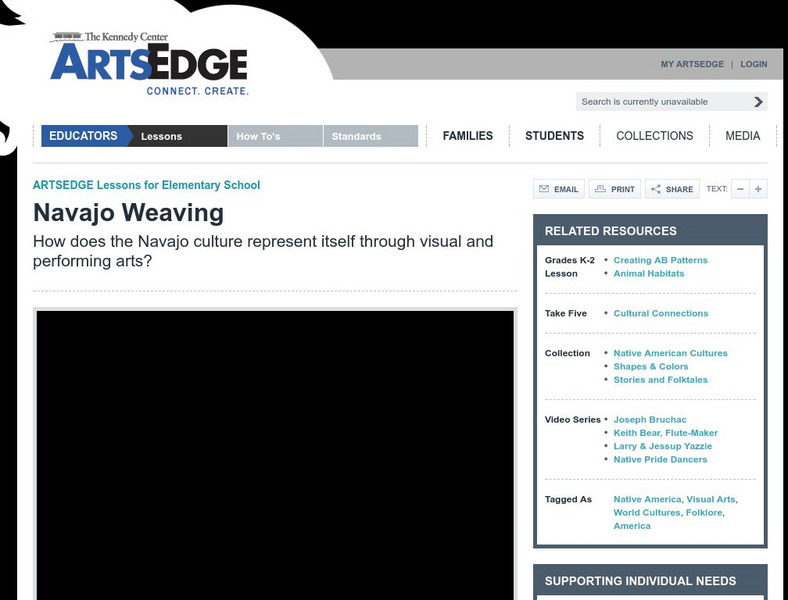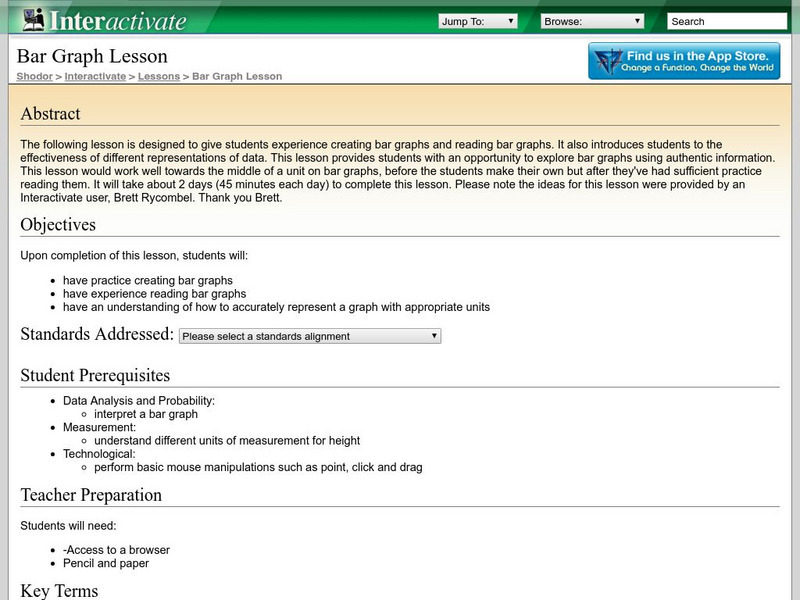John F. Kennedy Center
The Kennedy Center: Lesson: Navajo Weaving
Intergrating dance into your social studies lesson on the Navajo culture will give your students a glimpse into another way of life. They will use their knowledge of loom weaving, Native Americans, and creative dance to express these...
John F. Kennedy Center
The Kennedy Center: Brass Instruments and Pitch
Young scholars will enjoy making their own brass instrument with this interesting lesson plan. Objectives include what factors affect the pitch of brass instruments and what determines pitch.
John F. Kennedy Center
The Kennedy Center: Lesson: A Listening Doll
In this lesson plan, students explore the tradition of Pueblo "Listening dolls" and create their own version of this historical tradition. Also contains a rubric, extensions, and books to use as references.
John F. Kennedy Center
The Kennedy Center: Arts Edge: Navajo Weaving
After studying Navajo weaving and listening to the story "Ten Little Rabbits," students create their own interpretive dances. Contains an assessment checklist and extensions ideas.
National Endowment for the Humanities
Neh: Edsit Ement: Traditions and Languages of Three Native Cultures
This lesson plan helps students learn aspects of three Native American languages, the Tlingit, Lakota, and Cherokee. Five lessons lead teachers and students through traditions, similarities and differences, and the importance of...
PBS
Pbs Learning Media: Seven Selfish Shellfish
This video segment from Between the Lions features a classic tongue twister: a type of wordplay that helps children tune their ears to language and the sounds within words. [0:29]
Shodor Education Foundation
Shodor Interactivate: Lesson: Bar Graph
This lesson is designed to give students practice creating and reading bar graphs as well as understanding how to accurately represent a graph with appropriate units.
PBS
Pbs Learning Media: Classroom Tips
From managing the technology to tips for transporting video files, this resource offers practical advice and strategies for video use.
Science Buddies
Science Buddies: Project Ideas: Pet Poll: A Taste Test for Fluffy and Fido
In this mammalian biology science fair project, students will determine which brand, type, or flavor of treats their pet prefers. The Science Buddies project ideas are set up consistently beginning with an abstract, objective, and...
Science Buddies
Science Buddies: Are You in Hot Water? Use Solar Energy to Heat Your Own Water
The goal of this science fair project is to build batch solar collectors from different colors of plastic bags and see which collector is the most efficient in heating water.
Science Buddies
Science Buddies: Project Ideas: Whirl Y Bird vs. Whale Y Bird
Improve the design of a very simple aircraft, the whirlybird, and learn about hydrodynamics and biomimicry in this science experiment. The Science Buddies project ideas are set up consistently beginning with an abstract, objective, and...
Science Buddies
Science Buddies: The Bouba Kiki Effect
It may be possible for certain symbolic characteristics, like sharpness and roundedness, to cross language barriers. In this experiment you will investigate the Bouba-Kiki Effect to find out if abstract visual properties can be linked to...
PBS
Pbs Kids: Super Why: Princess Presto Spectacular Sounds Bingo
In this bingo game, listen for the sounds of the letters and click on the correct letter; when you have completed all the letters, a picture is revealed.
Huntington Library
Huntington Library: Garden Lesson Plans: Seeing Seeds [Pdf]
An exploration for younger students into the diversity of seeds and what is inside a seed. Includes extension activities.
Chase Young, PhD
Dr. Chase Young, Ph D: Reader's Theater Script: Arthur's Christmas [Pdf]
A reader's theater script for Marc Brown's children's book, Arthur's Christmas, is provided on these pages. Ten character roles are needed in this activity.
Chase Young, PhD
Dr. Chase Young, Ph D: Reader's Theater Script: Jack, the Cunning Thief [Pdf]
A reader's theater adaptation of the Celtic fairy tale, Jack, the Cunning Thief, is provided on this script. Seventeen character roles are needed in this performance.
Chase Young, PhD
Dr. Chase Young, Ph D: Reader's Theater Script: Helen Lester's Me First [Pdf]
A reader's theater script for Helen Lester's children's book, Me First, is provided on these pages. Eight character roles are needed in this activity.
Chase Young, PhD
Dr. Chase Young, Ph D: Reader's Theater Script: The Three Little Wolves and the Big Bad Pig [Pdf]
A reader's theater script for Eugene Triviza's children's picture book, The Three Little Wolves and the Big Bad Pig, is provided on these pages. Fifteen character roles are needed in this activity.
Chase Young, PhD
Dr. Chase Young, Ph D: Reader's Theater Script: Redheaded Robbie's Christmas Story [Pdf]
A reader's theater script for Bill Luttrel's children's book, Redheaded Robbie's Christmas Story, is provided on these pages. Ten character roles are needed in this activity.
BioEd Online
Bio Ed Online: Living Things and Their Needs: We Need Water
This activity focuses on living things' need for water. Students make lemonade and learn that water can be found in liquids other than a glass of water, and is also found in plants. The activity can be downloaded in PDF format.
BioEd Online
Bio Ed Online: Living Things and Their Needs: Need or Want?
Students learn the difference between wanting something and needing something in order to survive. The activity can be downloaded in PDF format.
BioEd Online
Bio Ed Online: Living Things and Their Needs: Animals' Needs
Students learn about the basic needs of animals by creating and observing a worm terrarium. The lesson and student worksheets can be downloaded in PDF format.
BioEd Online
Bio Ed Online: Resources and the Environment: Is It Natural or Transformed?
In this activity, students learn about natural resources. They sort materials into two categories, whether it is natural or if it has been changed by humans.
BioEd Online
Bio Ed Online: Resources and Animals
In this lesson students will observe, examine, discuss and draw a walking stick insect or acrawfish in its natural environment in order to understand resources and animals.
















